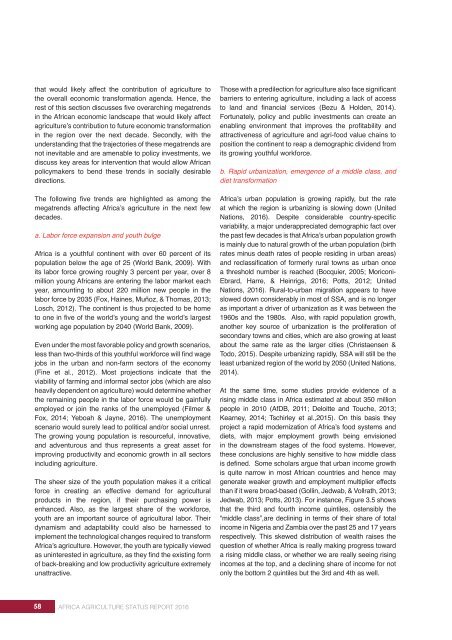AFRICA AGRICULTURE STATUS REPORT 2016
AASR-report_2016-1
AASR-report_2016-1
Create successful ePaper yourself
Turn your PDF publications into a flip-book with our unique Google optimized e-Paper software.
that would likely affect the contribution of agriculture to<br />
the overall economic transformation agenda. Hence, the<br />
rest of this section discusses five overarching megatrends<br />
in the African economic landscape that would likely affect<br />
agriculture’s contribution to future economic transformation<br />
in the region over the next decade. Secondly, with the<br />
understanding that the trajectories of these megatrends are<br />
not inevitable and are amenable to policy investments, we<br />
discuss key areas for intervention that would allow African<br />
policymakers to bend these trends in socially desirable<br />
directions.<br />
The following five trends are highlighted as among the<br />
megatrends affecting Africa’s agriculture in the next few<br />
decades.<br />
a. Labor force expansion and youth bulge<br />
Africa is a youthful continent with over 60 percent of its<br />
population below the age of 25 (World Bank, 2009). With<br />
its labor force growing roughly 3 percent per year, over 8<br />
million young Africans are entering the labor market each<br />
year, amounting to about 220 million new people in the<br />
labor force by 2035 (Fox, Haines, Muñoz, & Thomas, 2013;<br />
Losch, 2012). The continent is thus projected to be home<br />
to one in five of the world’s young and the world’s largest<br />
working age population by 2040 (World Bank, 2009).<br />
Even under the most favorable policy and growth scenarios,<br />
less than two-thirds of this youthful workforce will find wage<br />
jobs in the urban and non-farm sectors of the economy<br />
(Fine et al., 2012). Most projections indicate that the<br />
viability of farming and informal sector jobs (which are also<br />
heavily dependent on agriculture) would determine whether<br />
the remaining people in the labor force would be gainfully<br />
employed or join the ranks of the unemployed (Filmer &<br />
Fox, 2014; Yeboah & Jayne, <strong>2016</strong>). The unemployment<br />
scenario would surely lead to political and/or social unrest.<br />
The growing young population is resourceful, innovative,<br />
and adventurous and thus represents a great asset for<br />
improving productivity and economic growth in all sectors<br />
including agriculture.<br />
The sheer size of the youth population makes it a critical<br />
force in creating an effective demand for agricultural<br />
products in the region, if their purchasing power is<br />
enhanced. Also, as the largest share of the workforce,<br />
youth are an important source of agricultural labor. Their<br />
dynamism and adaptability could also be harnessed to<br />
implement the technological changes required to transform<br />
Africa’s agriculture. However, the youth are typically viewed<br />
as uninterested in agriculture, as they find the existing form<br />
of back-breaking and low productivity agriculture extremely<br />
unattractive.<br />
Those with a predilection for agriculture also face significant<br />
barriers to entering agriculture, including a lack of access<br />
to land and financial services (Bezu & Holden, 2014).<br />
Fortunately, policy and public investments can create an<br />
enabling environment that improves the profitability and<br />
attractiveness of agriculture and agri-food value chains to<br />
position the continent to reap a demographic dividend from<br />
its growing youthful workforce.<br />
b. Rapid urbanization, emergence of a middle class, and<br />
diet transformation<br />
Africa’s urban population is growing rapidly, but the rate<br />
at which the region is urbanizing is slowing down (United<br />
Nations, <strong>2016</strong>). Despite considerable country-specific<br />
variability, a major underappreciated demographic fact over<br />
the past few decades is that Africa’s urban population growth<br />
is mainly due to natural growth of the urban population (birth<br />
rates minus death rates of people residing in urban areas)<br />
and reclassification of formerly rural towns as urban once<br />
a threshold number is reached (Bocquier, 2005; Moriconi-<br />
Ebrard, Harre, & Heinrigs, <strong>2016</strong>; Potts, 2012; United<br />
Nations, <strong>2016</strong>). Rural-to-urban migration appears to have<br />
slowed down considerably in most of SSA, and is no longer<br />
as important a driver of urbanization as it was between the<br />
1960s and the 1980s. Also, with rapid population growth,<br />
another key source of urbanization is the proliferation of<br />
secondary towns and cities, which are also growing at least<br />
about the same rate as the larger cities (Christaensen &<br />
Todo, 2015). Despite urbanizing rapidly, SSA will still be the<br />
least urbanized region of the world by 2050 (United Nations,<br />
2014).<br />
At the same time, some studies provide evidence of a<br />
rising middle class in Africa estimated at about 350 million<br />
people in 2010 (AfDB, 2011; Deloitte and Touche, 2013;<br />
Kearney, 2014; Tschirley et al.,2015). On this basis they<br />
project a rapid modernization of Africa’s food systems and<br />
diets, with major employment growth being envisioned<br />
in the downstream stages of the food systems. However,<br />
these conclusions are highly sensitive to how middle class<br />
is defined. Some scholars argue that urban income growth<br />
is quite narrow in most African countries and hence may<br />
generate weaker growth and employment multiplier effects<br />
than if it were broad-based (Gollin, Jedwab, & Vollrath, 2013;<br />
Jedwab, 2013; Potts, 2013). For instance, Figure 3.5 shows<br />
that the third and fourth income quintiles, ostensibly the<br />
“middle class”,are declining in terms of their share of total<br />
income in Nigeria and Zambia over the past 25 and 17 years<br />
respectively. This skewed distribution of wealth raises the<br />
question of whether Africa is really making progress toward<br />
a rising middle class, or whether we are really seeing rising<br />
incomes at the top, and a declining share of income for not<br />
only the bottom 2 quintiles but the 3rd and 4th as well.<br />
58 <strong>AFRICA</strong> <strong>AGRICULTURE</strong> <strong>STATUS</strong> <strong>REPORT</strong> <strong>2016</strong>


